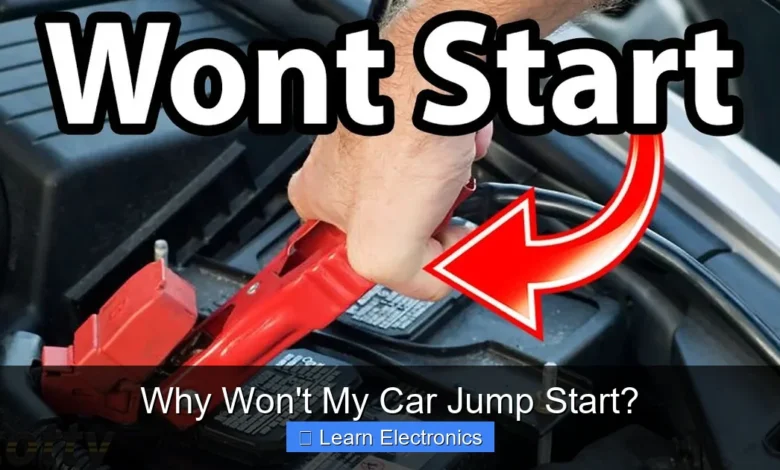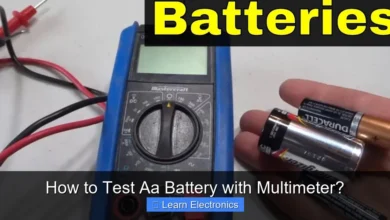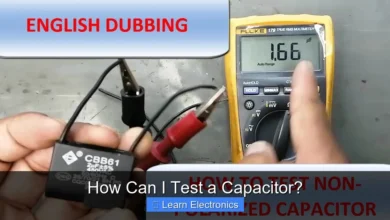Why Won’t My Car Jump Start?

Why Won’t My Car Jump Start? Often, it’s not simply a dead battery, but a more complex interplay of factors ranging from faulty connections to underlying electrical system failures. Understanding these reasons is crucial to effectively troubleshoot this common automotive problem and avoid further frustration with the process.
Quick Answers to Common Questions
My battery seems completely dead, could that be why won’t my car jump start?
Yes, if your battery is utterly flat, it might not accept a charge from a simple jump start. Sometimes it needs a longer charge, or it could mean the battery is beyond saving and needs replacement.
I connected the cables correctly, but why won’t my car jump start?
Even with correct connections, dirty or corroded battery terminals can prevent a good electrical flow. Also, ensure the donor car is running and has sufficient voltage to power your vehicle.
If it’s not the battery, why won’t my car jump start?
A failed starter motor is a common culprit; you might hear a clicking sound but no engine turnover. Less often, it could be an alternator issue, a problem with your ignition system, or even a lack of fuel.
📑 Table of Contents
- The Battery Itself: Beyond a Simple Boost
- Connection and Cable Issues: A Common Pitfall
- Problems with the Donor Vehicle or Its Battery
- Why Won’t My Car Jump Start? Deeper Electrical System Failures
- User Error and Environmental Factors Affecting the Jump Start Process
- When to Call for Professional Help
The Battery Itself: Beyond a Simple Boost
Even if you correctly connect the jumper cables, a car’s battery might refuse to take a charge if it’s too far gone. Batteries have a finite lifespan, typically 3-5 years, and various issues can render them un-jump-startable.
Deeply Discharged Batteries
A battery that has been completely drained for an extended period, perhaps by leaving headlights on overnight for several days, can enter a state of deep discharge. In this condition, the battery might not have enough residual voltage to accept a charge from the donor vehicle, no matter how long you try to boost it. The internal chemistry can be altered, making it unable to hold a charge.
Sulfation and Internal Damage
Over time, lead-acid batteries develop lead sulfate crystals on their plates, a process called sulfation. While normal, excessive sulfation, often due to prolonged undercharging or deep discharge, can harden these crystals, making the battery inefficient or even completely incapable of producing or storing electricity. Internal short circuits, caused by plate damage or shedding, are also irreparable and will prevent any attempt to revive the battery using this technique.
Cold Weather Impact
Extreme cold significantly reduces battery efficiency. The chemical reactions slow down, and the battery’s ability to deliver current is diminished. While a healthy battery can handle cold, an already weak battery might simply lack the power to crank the engine in freezing temperatures, even with assistance. This environmental factor often exacerbates existing battery issues.
Connection and Cable Issues: A Common Pitfall
Improperly connected jumper cables or faulty cables are among the most frequent reasons a car won’t start after an attempt to revive it. Precision and proper maintenance are key to the practice of jump starting.
Incorrect Cable Hookup
The correct sequence and polarity are vital: positive (+) to positive, negative (-) to a bare metal ground on the dead car (away from the battery and fuel system), then negative to negative on the donor battery. Reversing polarity can cause sparks, damage electrical systems in both vehicles, and definitely prevent a successful jump. Ensure the clamps are firmly attached to clean, corrosion-free terminals.
- Red Clamp (Positive +): Connect to the positive terminal of the dead battery, then to the positive terminal of the donor battery.
- Black Clamp (Negative -): Connect to the negative terminal of the donor battery, then to an unpainted metal surface on the engine block or chassis of the dead vehicle (away from moving parts).
Corroded Battery Terminals
Fuzzy, white, or greenish buildup on battery terminals indicates corrosion. This acts as an insulator, preventing a good electrical connection. Even with strong jumper cables, the current might not be able to pass through this resistance. Always clean corroded terminals with a wire brush and baking soda solution before attempting a jump start.
Damaged or Cheap Jumper Cables
Thin, cheap jumper cables might not be able to carry enough current to start a larger engine, especially in cold weather. Wires inside the insulation can also break or fray over time, creating a high-resistance point that limits current flow. Inspect your cables for any cuts, cracks, or signs of wear before relying on this method.
Problems with the Donor Vehicle or Its Battery
Sometimes, the issue isn’t with the car that needs the jump, but with the car providing the power. The success of this approach hinges on a robust power source.
Weak Donor Battery
If the donor vehicle’s battery is also weak or not fully charged, it won’t have enough power to transfer to the dead battery and crank the engine. The donor car should ideally have a healthy, fully charged battery to provide sufficient amperage.
Donor Vehicle Not Running
For most jump starts, the donor vehicle’s engine should be running after the cables are connected. This allows the alternator to charge its battery and provide additional power to the circuit, ensuring a stronger current flow to the recipient car. If the donor car is off, its battery might drain quickly without successfully starting the other vehicle.
Insufficient Engine Size of Donor Car
A small compact car trying to jump-start a large SUV or truck with a significantly larger engine and battery might struggle. The smaller vehicle’s electrical system and battery simply might not be designed to provide the massive current surge required by the larger engine, making the process ineffective.
Why Won’t My Car Jump Start? Deeper Electrical System Failures
If the battery and connections seem fine, the problem might lie within other critical components of your car’s electrical system. A jump start only addresses a dead battery; it can’t fix mechanical or other electrical failures.
Faulty Starter Motor
The starter motor is responsible for turning the engine over to initiate combustion. If you hear a single click or nothing at all when you turn the key, even with a strong battery, the starter motor might be bad. A jump start won’t bypass a mechanically failed starter; it will still fail to engage the engine.
Bad Alternator
The alternator recharges the battery while the engine is running and powers the car’s electrical systems. If your car starts with a jump but then quickly dies after the cables are removed, it’s a strong indicator of a failing alternator. The battery isn’t being recharged, and the car is running solely on battery power, which quickly depletes. This means the underlying issue persists even if the car temporarily starts.
Blown Fuses or Relays
Modern cars have numerous fuses and relays protecting various electrical circuits. A blown fuse related to the starting system (e.g., ignition fuse, starter fuse) or a faulty starter relay can prevent the car from starting, regardless of battery health. Checking your fuse box for any visibly broken fuses related to the starting circuit is a good diagnostic step.
Ignition System Problems
Issues with the ignition switch itself, ignition coils, spark plugs, or other components of the ignition system can prevent the engine from firing up. If the engine cranks but doesn’t “catch,” the problem might be ignition-related rather than battery or starter-related. A jump start is irrelevant in this scenario.
User Error and Environmental Factors Affecting the Jump Start Process
Sometimes, the failure to jump start isn’t due to a fault with the car but with how the attempt is made or the conditions under which it occurs.
Not Enough Time
After connecting the cables, you often need to let the donor vehicle run for 5-10 minutes to allow the dead battery to receive an initial charge. Trying to start the car immediately after connecting the cables might not give the battery enough time to accumulate sufficient power, making the practice seem ineffective.
Electronic Glitches or Immobilizers
Modern cars are equipped with complex electronic systems and immobilizers to prevent theft. A sudden power loss or surge during a jump start attempt can sometimes trigger these systems, preventing the car from starting even if the battery has enough power. In such cases, consult your car’s manual or a professional.
Fuel Issues
It sounds basic, but sometimes the car simply doesn’t have fuel. A jump start won’t magically add gasoline. Always check your fuel gauge if the engine cranks but doesn’t fire up.
When to Call for Professional Help
While understanding these common issues empowers you to troubleshoot, there are times when professional intervention is the safest and most efficient solution.
If you’ve tried all the basic jump-starting techniques, inspected your cables and connections, and still can’t get your car to start, it’s time to consider calling roadside assistance or a mechanic. Trying repeatedly to jump a car that won’t start can sometimes cause further damage to the electrical systems of both vehicles involved. A professional can diagnose underlying issues with specialized equipment, determine if your battery is truly dead or if another component like the alternator or starter needs replacement, and perform repairs safely.
| Symptom | Potential Problem | Solution |
|---|---|---|
| No lights, no sound, completely dead. | Deeply discharged or internally damaged battery. | Replace battery. |
| Clicking sound, no crank. | Weak battery, corroded terminals, or faulty starter. | Clean terminals, attempt jump start (longer), or check starter. |
| Engine cranks slowly, doesn’t start. | Weak battery, cold weather, or fuel/ignition issues. | Allow more charging time, check fuel/ignition components. |
| Car starts with jump, dies immediately after cables removed. | Bad alternator. | Replace alternator. |
| Car cranks but doesn’t fire up. | Ignition system fault, fuel issue, or blown fuse. | Check fuses, fuel level, ignition components. |
| Sparks when connecting cables. | Incorrect polarity or loose connection. | Reconnect cables correctly and securely. |
A car refusing to jump start can be incredibly frustrating, but by methodically working through these common causes, you can often identify the root of the problem. From simple cable connection errors to more serious electrical component failures, understanding the possibilities is the first step toward getting your vehicle back on the road safely and efficiently. If in doubt, never hesitate to seek professional assistance.
Frequently Asked Questions
How do I ensure my jump start cables are connected properly?
Incorrect cable connection is a common reason a car won’t jump start. Always connect the red (positive) clamp to the positive terminal of the dead battery, then the other red clamp to the positive terminal of the donor battery. Next, connect the black (negative) clamp to the negative terminal of the donor battery, and finally, the other black clamp to an unpainted metal surface on the engine block or frame of the dead car, away from the battery.
Could a completely dead car battery prevent a successful jump start?
Yes, an extremely discharged or internally damaged car battery might not hold a charge from a jump start. If your battery is old, has visible corrosion, or the car has been sitting for a very long time, it might need more than a simple jump start or could be beyond recovery. In such cases, the battery may need to be replaced.
What if the donor car or portable jump starter isn’t providing enough power?
The donor vehicle needs to be running and have a healthy electrical system to effectively jump start another car. If you’re using a portable jump starter, ensure it’s fully charged and has sufficient cranking amps for your vehicle’s engine size. A weak donor source can definitely explain why your car won’t jump start.
My car clicks rapidly or makes no sound when I try to jump start it. What does this mean?
If you hear rapid clicking, it often indicates a low battery charge that’s still not strong enough to engage the starter, or possibly loose/corroded connections. No sound at all after attempting a jump start could point to a completely dead battery, severely corroded terminals, or a faulty starter motor not receiving any power. Double-check all connections and try wiggling the clamps.
Are there other electrical issues or component failures that stop my car from jump starting?
Beyond the battery, other issues can prevent a successful jump start. A faulty starter motor, a blown main fuse, or severely corroded battery terminals can all block the flow of power needed to start the car. Even with a good jump, these underlying electrical problems will still keep your car from starting.



